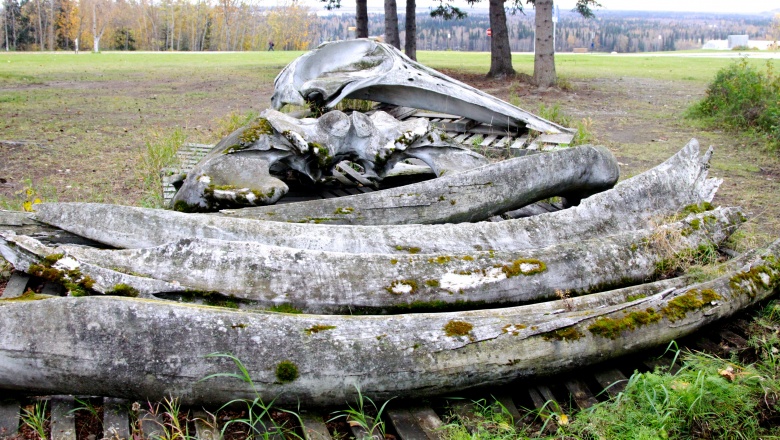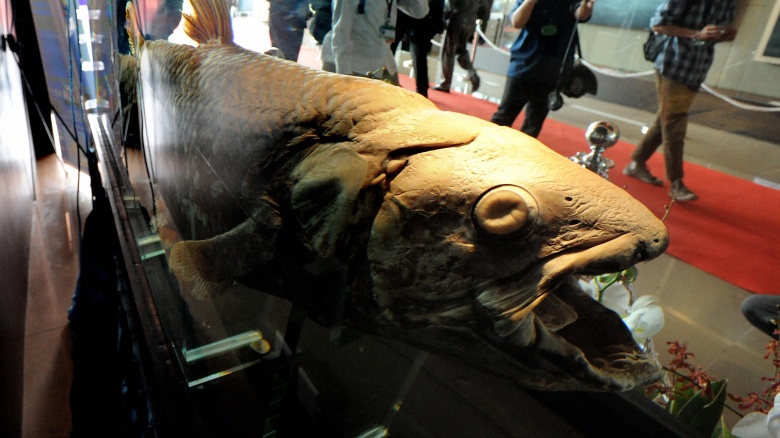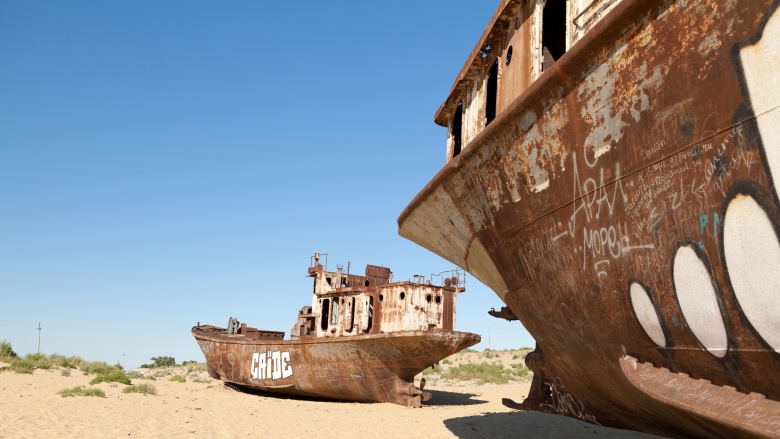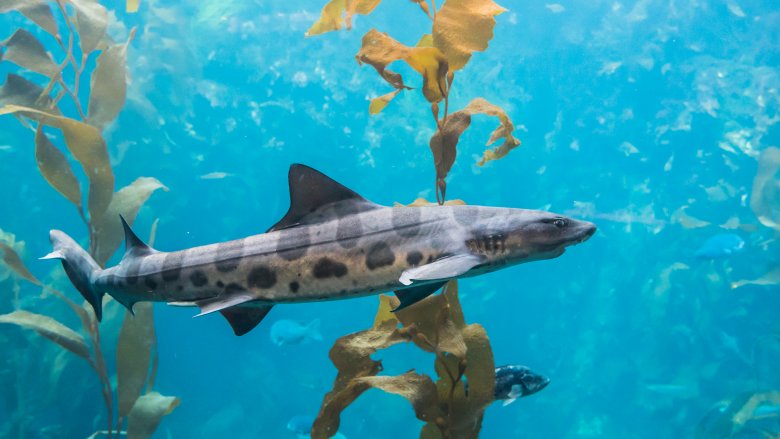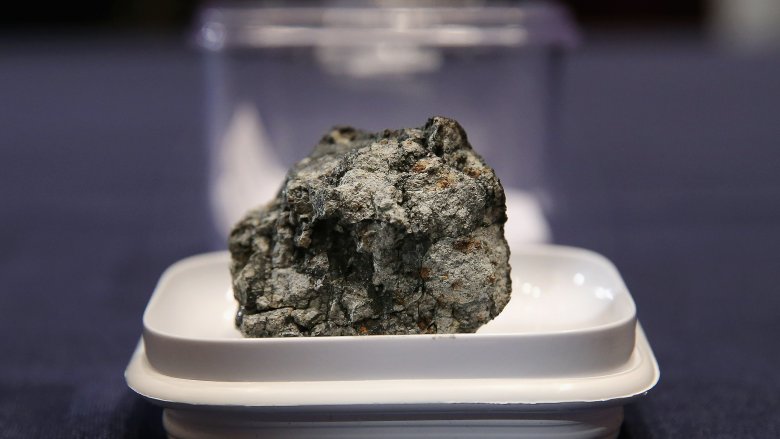Things Found In Bizarre Locations Where They Shouldn't Be
The world is a weird place, full of bizarre finds that completely throw you for a loop, because there's just no reasonable, rational explanation for why they are where they are. Sometimes, if we're lucky, we eventually learn why. Sometimes, it remains a mystery forever.
Indian cobras in Missouri
Even if you like snakes, you have a good reason to be terrified of Indian cobras. As the name suggests, they're native to southeast Asia, they're incredibly venomous, and of the few insane people that keep them as pets? Those people sometimes die.
So when they showed up on the streets and in the gardens of Springfield, Missouri in 1953, people had a good reason to panic. At least eleven of the snakes were dispatched by various means (including garden tool and car) between August and October, and the most logical source for the snakes denied he had any involvement in their weird appearance. The Mowrer Animal Company was paid a police visit, but they weren't missing any snakes. We're pretty sure they'd notice.
The Mowrer behind the Mowrer Animal Company kept denying things up until his death, and it wasn't until 1988 that another man came forward to admit he'd unleashed the plague on the town. Unhappy with the quickly-dead fish he'd gotten from the town pet store, Carl Barnett decided to take a little revenge on the store owner. By unleashing snakes. According to his story, he didn't realize they were cobras when he opened the crate sitting in a back alley, which just goes to show it never hurts to be able to identify deadly creatures.
Fish in Honduras (over 100 miles from an ocean)
For at least the last century, the landlocked city of Yoro, Honduras has reported a strange phenomenon. For a few days in May or June, residents will head out of their homes to streets filled with hundreds of small, blind silverfish. They usually show up after major thunderstorms, leading locals to believe in a phenomenon they call "lluvia de peces" — literally, "rain of fish".
It's not a very creative name, granted, but it's definitely an accurate one. Unfortunately, there hasn't been many actual scientific studies done on it, and that's a shame because we seriously want to know what's going on here. The usual explanation for fish rains is waterspouts, but Yoro is around 45 miles away from the ocean. That's a long way for fish to travel, and there's another problem with the theory. The fish that are showing up in Yoro? They're definitely not indigenous to the area, and no one knows where the heck they might be coming from.
There are a few theories as to what's going on. According to one story, National Geographic did an investigation in the 1970s, but no one seems to be able to dig up any official information or articles on whatever they found there. The consensus is that they found the fish weren't coming from the sky, but from underground, and they were showing up only after heavy rains flooded out whatever underground waterway they're living in.
Another theory is more spiritual, and says that the fish are a gift. In the 1860s, Father Jose Manuel Subirana was passing through the area, and prayed the people there would find relief from starvation. His prayers were answered in the form of fish rain which, if that's the case, you'd think he would've prayed for it to happen more often than once a year.
Whale fossils at a Vermont farm
In 1849, workers were building a railroad across Vermont when they dug up something weird in the middle of a farmer's field. It was a whale, not exactly the usual companion to corn and tomatoes.
It was odd, for sure, made even odder by how the ocean was around 200 miles away. There were also two mountains ranges in the way. At the time, no one was really sure just how the Earth had been formed, and many looked at the whale skeleton as proof that a great flood had once submerged the planet. The whale, now affectionately called Charlotte, was proof that Noah was real.
Her skeleton was assembled completely in 1861, and she's not entirely put together right. Early damage was repaired with burlap and boot polish, and she still looks a little ... off. (They like it that way, it gives her a bit of character.) Incidentally, she was almost destroyed in a flood in 1927, and even though she's still around today the preservation methods that were used mean we can't accurately date the bones.
Since her discovery, researchers have found out a little more about the area and have dated her to sometime around 12,500 years ago, when a sheet of glacial ice receded across the area and created the Champlain Sea. For the next 2,500 years, the sea was flooded by the Atlantic and, at some point, Charlotte died there and was left in what's now an inland state.
An extinct prehistoric fish found alive on a South African fishing boat
In December of 1938, the curator of East London's natural history museum, Marjorie Courtenay-Latimer, got a phone call from a local fisherman. He'd netted some sharks and some weird fish, and he was wondering if she wanted to come see if there were any that she might want for the museum. When she got there, she found something that she most definitely wanted: a coelacanth, a fish that had gone extinct around 70 million years earlier, give or take a millennia or three. No one believed there was any way it could possibly be found there, or anywhere.
Latimer and a colleague, J.L.B. Smith, eventually confirmed that the fish was one of prehistoric origins. Since then, we've found members of two different species of coelacanth, even though there were at least 90 at one time. The prehistoric fish are, understandably, incredibly weird. They give birth to live young, live in only a couple of areas in the world, and spend most of their time in what's called the "twilight" area of the ocean. It's just above the deepest, darkest part of the ocean, so it's no wonder we thought they were extinct. Even now, we're not sure what the deal with them is, and where they fall on the evolutionary ladder of the world's oceans.
Nanotechnology in a 1,600-year-old chalice
What's more cutting-edge and high-tech than nanotechnology, right? It's the stuff of science fiction and ... ancient Rome.
The British Museum got the Lycurgus Cup in the 1950s, and for decades, they had no idea how it worked. The cup changed color, a lot. When lit from one side, it was green. When lit from the other side, it's red. It wasn't until the 1990's, when our technology advanced enough that the museum was able to look at broken pieces of the cup on a super-microscopic scale. When they did, they found that the color change was done with a technology that we're only starting to understand.
Bits of gold and silver were ground down into tiny, tiny, tiny pieces. They measured only about 50 nanometers in size, less than a thousandth of the size of a single grain of table salt. Those tiny grains were then put in the glass that was made into the cup, and its precise, exact nature suggests the ancient Romans knew exactly what they were doing and how to do it.
They weren't just making something that turned pretty colors when you held it to the light, either. When researchers created a "cup" that used the same type of technology that they could experiment with, they learned the colors also changed based on what kind of liquid was poured in. Not a bad party trick for 16 centuries ago.
The Bouvet Island lifeboat
A critical detail for this one is just how far away from absolutely anything else Bouvet Island is, and how relatively tiny it is. There's no other piece of land within a 1,000-mile radius, and it's only a few square miles in size — needless to say, there's absolutely no reason to go there. And yet, there's a lifeboat.
The island was discovered in 1739, when polar explorers stumbled on it by accident. It was so insignificant that they charted it wrong, and it foiled all attempts to find and chart it again until 1898, when the Germans finally mapped all three-by-five miles of it. They just sailed around, noting that it was all icy cliffs and no hospitality, and then moved on. It wasn't until 1964 that South Africa decided that it might be a handy place to set up a weather station, and headed out to actually explore the island. It was then that they found the lifeboat.
It was still seaworthy, and it was sitting in a lagoon. There were no markings and no clues as to what country it might have come from, and the weather was so bad, the crew that discovered it couldn't hang around to look at it more. Surprisingly, not too many people wondered what the heck kind of miracle brought the boat to the most remote place on Earth and left it there.
It turns out that the collective crowdsourcing power of the internet may have stumbled across the answer, buried in a text called "Transactions of the Oceanographical Institute." A small note mentions the crew of a whaling ship called the Slava-9, who was scouting the area for its potential. Part of the crew got trapped on Bouvet Island in terrible weather, and they were airlifted out on November 27, 1958. They left their lifeboat behind.
The desert's ship graveyard
Scattered across the desert of Uzbekistan is an unlikely sight. Massive ships might be the last thing you'd expect to see in the desert (unless you're playing Legend of Zelda), but that's exactly what litters the desert outside of the city of Moynaq. Ships big and small rust away in the hot desert sun as they're put to use providing shade for camels and other desert animals. What they're definitely not doing is sailing any kind of sea.
So what's the deal? The desert the ships now sit in is all that remains of what was once the world's fourth-largest sea — so vast that it supplied the Soviet Union with about a sixth of its fish, and employed between 40,000 and 60,000 people. The Aral Sea has been a recent victim of progress, environmental disregard, and ideas that clearly weren't thought through completely before they were put into play. Dates vary, but at some point before the mid-1960s, plans were put in place to use the waters of the Aral Sea's nearby rivers to irrigate new farmland. That cut off a major source of freshwater flowing into the sea, and over the next few decades, the sea started to change. First, the salt content rose too high to keep supporting the abundant fish that had once lived there, and then the sea started drying up. Ecosystems died, people lost their jobs and moved away, and the desert started creeping in.
Ships that had once worked out of the Aral Sea's port cities were stranded in the sand as the water receded and the climate changed. Some of the skeletal ships have sat there for decades now, and while the Aral Sea hasn't disappeared completely, it's still an eerie reminder of the damage mankind can do.
Underwater trains
Where do old trains go to die? We're not sure, but we're pretty certain the answer isn't "at the bottom of the ocean." Yet in 1985, that's exactly where two Civil War-era locomotives were found, resting off the coast of New Jersey in about 90 feet of water.
There's really no explanation for this one, either. There's theories, but theories are a long way from facts, especially when there's no way to trace the history of either train, or even to pinpoint the year they were made, beyond "sometime in the early 1850s." One working theory is that the trains were being carried on a ship that was torpedoed during World War II, but the problem with that theory is, there's no signs of any sunken ship anywhere near the trains. Another theory suggests they were being shipped from Boston to somewhere else on the Atlantic Coast, when the ship they were on ran into some trouble. Another possible explanation is that the trains were dumped into the ocean to lighten the load.
As if that isn't weird enough, both trains were discovered in a rather odd position. Both were sitting completely upright, their barnacle-covered wheels sitting on the ocean floor (atop iron grates), as though they were patiently sitting and waiting for their ghost engineer to come start them up and take them away.
Wallabies in Ireland
Wallabies are adorable. They're little mini-kangaroos that, like their bigger relatives, are usually found scampering and kicking their way through the Australian outback. They thrive in hot weather, hot sun, and their native range is throughout Australia and a few surrounding islands. They're also found on an island off the coast of Ireland, despite that country's climate being pretty much the polar opposite of Australia, with more rain than sun and mildly cool days year round. But still, wallabies not only live, but thrive on the island of Lambay, just a few miles off Ireland's eastern coast.
They were first taken to the island in the 1950s, when a well-to-do family called the Barings decided it would be a great idea to use the island to raise all sorts of animals. Some, like the more unfortunate tortoises, didn't survive. The wallabies did, against all odds, and some experts think their ability to grow heavy fur coats had something to do with helping them weather Ireland's rainy, foggy climate. The creatures are also naturally shy, preferring to hide in the forests of the undeveloped island, and the rocky coastline at least sort of mimics their natural habitat.
More wallabies were shipped to the island in the 1980s, when the Dublin Zoo had a most unexpected problem, namely "too many wallabies." The director couldn't find homes for the extras, and rather than euthanize the healthy animals, he knew they would have a chance on the island. Those seven wallabies have multiplied to somewhere around 40, and anyone taking a boat tour around the island's perimeter might just see an unlikely, adorable face peeking out at them.
19th-century tombstones on a San Francisco beach
In 2012, those walking along Ocean Beach in San Francisco were treated to a completely surreal sight. Rather than the usual shells, seaweed, and occasional soda bottle, tombstones from the 19th century were appearing on the beach. Not weird enough? Some were so well-preserved, the names and dates were still clearly legible. One belonged to Emma Bosworth, who died in 1876. Another was the grave marker of Delia Presby Oliver, who died in childbirth in 1890.
So, what the heck? Were they buried on a beach and nobody noticed for 120 years? Not quite. It turns out that Emma, Delia, and others buried in San Francisco's cemeteries didn't necessarily rest in peace. At the turn of the century, the city put an end to all cemeteries within the city limits. That meant the bodies there needed to be moved, but in many cases, the tombstones were simply left behind. Since back then, nothing went to waste, the discarded tombstones were recycled for building projects that included dumping them along the beach to create a sort of grisly seawall. Eventually, erosion did what erosion always does, and revealed the rather odd reuse project.
A live shark on a golf course
We're hoping whoever decided to go for a nice, relaxing round of golf on October 22, 2012, at the San Juan Hills Golf Club didn't have a heart condition, because according to The Telegraph, that's where a 2-foot leopard shark dropped out of the sky.
It dropped on the 12th tee, to be precise, and it was very much alive. Who knows how it was still kicking, but it was probably magic. How it got there is better known — according to the course marshal who picked it up and put in it his cart, there were bloody puncture wounds where it had been grabbed by a bird who had apparently flown at least 5 miles before deciding it wasn't worth the trouble.
Don't worry; this story has a happy ending. Employees put the shark in some water, added sea salt from the kitchen, and headed off to return it to the Pacific. They did, and it swam off, presumably telling one heck of a tall tale none of his other shark friends ever believed.
A river beneath the water
The very definition of a river is water running through land, but divers exploring the watery depths of Mexico's Cenote Angelita found a river running where there's no land at all. From the surface, the cenote looks like a beautiful — but probably boring — pond. Dive in (expert divers only, please), and you'll swim down about 100 feet before you hit a murky river of hydrogen sulfide. It's the deadly stuff, it's about 10 feet thick, and according to veteran diver and videographer Mike Corey (via Science Alert), that's about the point most people start to panic. Make it through, and you're suddenly in saltwater.
Rivers like this one form because of the weird phenomenon that is the cenote. Collapsed limestone can open up a tunnel between the freshwater cenote and the saltwater ocean. The area where the two types of water meets is called the halocline, and it doesn't just flow, it separates two entirely different ecosystems. If you squint real hard and tilt your head, it can look like a land river ... except for the increased potential for death and drowning.
Lac de Gafsa
Imagine for a minute you live in Tunisia. It's hot, it's dry, there's a ton of desert, and not much else. There's a good reason it looks like Tatooine — Star Wars was filmed on your doorstep. You're walking home, and it's hot enough you think you might be hallucinating, because you swear there's a lake up ahead. A beautiful, turquoise lake, covering a part of the desert that definitely didn't have a lake there before.
You just imagined exactly what happened to Mehdi Bilel. The Guardian quoted him as saying, "I don't know much about science and thought it was magic, something supernatural." He wasn't alone, either, and when the mysterious lake appeared in late July 2014, Tunisian journalists reported that some people were suspicious this apparent blessing was a curse in disguise. Others thought it was a miracle. It turns out that "curse" and "miracle" were among the best guesses anyone had to explain what was going on, because other ideas included, "Who the heck knows?"
The water turned green only a few days after it showed up, so it wasn't being replenished. The lake — which was estimated to be as much as 60 feet deep and covered about 2.5 acres — may have been the result of the fracturing of ... something that was never found ... by an earthquake no one seems to remember feeling. That's one of the better theories, according to IFLScience. Since there's no evidence, let's stick with magic.
Stonehenge at the bottom of Lake Michigan
In 2007, research from the underwater archaeology department at Northwestern Michigan College turned up something cool, something that definitely wasn't the shipwrecks they were looking for. Sitting on the bottom of Lake Michigan under about 40 feet of water was a series of massive stones, arranged in a circular formation good enough to make the experts scratch their heads and slow down.
ZME Science says developments and research have been scarce, mostly because of how deep the stones are. The idea of an ancient civilization building a stone circle in what's now Lake Michigan is pretty awesome, and they may have left their signature, too. The photos they've been able to take show what may be a rock with a petroglyph carved into it, one that looks like a very cool rendering of a mastodon. Now we just need more pictures. Who's a diver here?
A masked shrike
How about a tale with a heck of a plot twist? Let's go back to 1892, when George Bristow was enjoying some serious good fortune with his taxidermy business. In 40 years, he "discovered" around 600 super-rare birds living around Sussex and Kent. Because this was the good old days, these rare species were killed, preserved, and sold for a pretty tuppence.
According to the Bohemia Village Voice, it wasn't until 1962 that British Birds (a journal) publicly declared the so-called Hastings Rarities complete frauds. Bristow, it turned out, wasn't finding the birds in England; he was importing them from Asia, Africa, Australia, and the Caribbean — all places where the birds were quite ordinary. He made thousands selling the birds he claimed he'd found in England and no one caught on. Researchers from the University of Aberdeen (PDF) say there were probably a few reasons for this, like the lack of Google. So, in the '60s, all the birds he'd claimed to find were struck from the British record.
Ready for the plot twist? Since then, many of the birds — like the masked shrike, the cute little fella pictured above — have been readmitted to the official listings of birds found in Britain. It turns out many of the birds he was importing were found in the U.K. after all, most flying over in their migratory patterns or even spending a few winter months there. Who's the foolish one now, George?
50,000-year-old creatures trapped in crystal
Even if you aren't familiar with the details, you've probably seen the photos of that cave filled with those unbelievably massive crystals. The cave is real, and so are the crystals. Mexico's Naica Mine was first opened in 1910, and a secondary cave was breached in 2000. The crystals weigh as much as 55 tons, and according to Atlas Obscura, it was formed millions of years ago after some freaky volcanic activity. Between temperature and humidity, it feels like it's around 230 degrees Fahrenheit inside, so exploring it has been next to impossible.
What's also impossible is what scientists found there in 2017. They found life, not just inside the cave, but inside the crystals themselves. After finding tiny pockets inside the crystals, they extracted some of the liquid inside and sent it off for analysis. According to Science Alert, they found tiny life forms that had been in a sort of self-induced suspended animation for as long as 50,000 years. Feelin' sci-fi yet? NASA scientists extracted the creatures — which had been surviving on iron and sulfur — woke them up, and got them to multiply. They say there's nothing else like them on Earth. Does anyone watch movies? They always end the same way.
Spiders that live underwater
Hate spiders? Feel safe from spiders when you're swimming? Kiss that comfort goodbye. According to Wired, you can be petrified of the diving bell spider if you're taking a dip in bodies of freshwater in Asia or Europe.
Within a few weeks of being born, these little creepers leave their mom's underwater refuge and spin what's essentially a little underwater bubble house. Strings of silk are stretched to the surface like climbing ropes, and spiders stick their butts above the water to grab some air bubbles before heading back down the silk, into the depths, and their little house. Bubble web. Whatever. Again, not making this up, sadly.
Spiders stash their little air bubbles in the bubble homes, then add more silk, more air bubbles ... you get the idea. What they end up with is an underwater air pocket that honestly seems like so much work it can't possibly be a practical adaptation. Thus is the nature of cosmic pranks.
The Calaveras Skull
In 1866, James Mattenson decided to take a chance and dig a mine into the potentially gold-filled depth of Calaveras County, California. Unfortunately for him, 100 feet down he found plenty of lava, gravel, and volcanic sediment but not a lot of gold. He went 50 more feet and found something he absolutely shouldn't have — an ancient human skull.
The skull ended up with a state geologist, and according to ScienceBlogs, it would rewrite everything we knew about human history. Based on where it was found, the geologist dated the skull to the Pliocene, which was 2.6 million to 5.3 million years ago. Needless to say, the sediment really hit the fan when everyone from Young Earth creationists to Harvard scientists realized they were going to have to do some serious soul-searching about what the skull meant for human history.
Fortunately, Smithsonian scientist and voice of reason W.H. Holmes got his hands on the skull and found snail shells and a few beads in the surrounding sediment. Holmes said the whole thing was clearly a load of horse poop, but it wasn't until the turn of the 20th century that the whole thing was conclusively revealed as a hoax. The skull was planted there, which just goes to show that an archaeological forgery doesn't have to be complicated to fool a ton of people.
Seeds embedded in an ancient meteorite
In 1864, a massive meteorite fell in southern France. Meteorites of that size are pretty rare in their own right, but it got even stranger. The rocks were called the Orgueil meteorites, and they were passed out to various museums and other important places that could really appreciate what they had. According to writer and researcher Ferris Jabr, the meteorite wasn't just huge — it was one of the oldest meteorites ever found, likely predating our solar system. Cool, right?
That's what makes it even more shocking that a few French chemists starting claiming they had found organic matter in the rock. Silly scientists! Only ... the results were supported by research done in 1962 at Fordham University. They found pollen and fungal spores in the rock that absolutely shouldn't have been there.
The results — which were published in the respected journal Nature — prompted Chicago researchers to decide to crack open their rock. When they did, they found little seeds. That discovery was earth-shattering ... until it wasn't. Further testing revealed that the already soft meteorite had been soaked to make it more malleable, then had the seeds inserted (planted?) inside. The final proof seemed to come when they realized there was some good ol' 19th-century glue painted over the surface of what had been an awesome space rock, until some jerk mucked with it.


